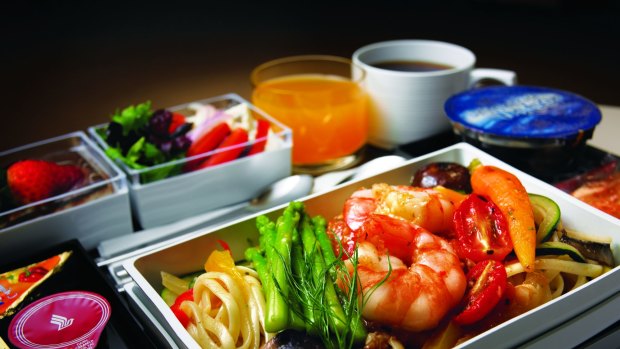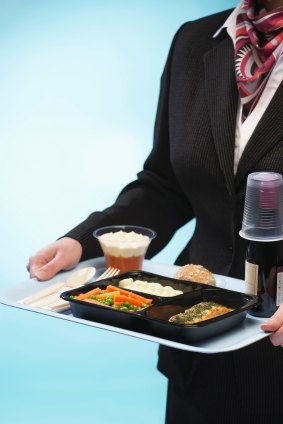This was published 9 years ago
Airline food preparation: Five secrets about airline food
By Sarah McInerney

Singapore Airlines economy meal.
With its compact space and utilitarian compartments of grey, it's hard to imagine airline galleys generating a cup of tea and a sandwich, let alone a three-course meal. Behind those latched doors with their short and sharp labels are steam ovens, pod coffee machines, microwaves and warming cabinets.
Cabin crew are trained on everything from safety measures to the correct implement to serve up a bread roll in first class. But that's only the tip of the iceberg. At the SATS catering facility one near Singapore's Changi Airport, 43,000 meals a day are produced for the likes of Singapore Airlines, Cathay Pacific and Qantas. This giant factory prepares and cooks inflight meals across 11 kitchens, with specialised areas for dim sum and desserts. There's even a flight simulator where regular taste tests are conducted at 10,000 metres.
Traveller asked the hard questions.
1. Why does the tea and coffee always taste so bad?
Temperature seems to be the biggest factor here. Water boils at about 100C on the ground, but can't reach that temperature in the air. Betty Wong, divisional vice president, customer experience at Singapore Airlines says: "Because it is not 100 degrees boiling point temperature, sometimes the flavour of the tea does not come up immediately, but if you let the teabag soak for a while, a little bit longer, you will get the same tea." Dry sinuses can also play a part, says Hermann Freidanck, the airlines' food and beverages manager. This is addressed by a specific coffee blend. "You have to have a different ratio of Arabica to Robusta for that," he says. "You need for stabilisation a little higher proportion of Robusta."
2. Why can inflight food give you flatulence?

Flight attendant with food tray.Credit: iStock
Freidanck says the ingredients, such as onions, that are to blame, not the dishes themselves. "We try to avoid [onions]. It's the process. You reheat, that means whatever happens with onions is already advanced," he says.
A study published in the the New Zealand Medical Journal in 2013 surmised that it was possible more intestinal gas was produced at cruising altitude than on the ground because of limitations in cabin pressure.
3. Why is red wine often served chilled on a flight?
According to Singapore Airlines wine consultant Jeannie Cho Lee, this is because of how it is stored. "It is usually very cold because they take it straight from their cooling unit," she says. "It depends on the plane, but it's usually below 10 degrees. That means for red wines, you need to warm it up."
Other factors affecting the taste of a wine in the air are dehydration, a decrease in saliva production and being a little flustered at the start of a flight, she says. In choosing wines, volume is a big consideration for economy-class flights, as is the ability to supply the wine in lightweight glass bottles. Wine structure is important too. "We don't want wines to have really aggressive oak or fruit tannins. Because the tannins tend to overcome the fruit even more in the air," she says.
4. Are there some foods you just can't serve in the air?
Sydney chef Matt Moran, a member of the Singapore Airlines culinary panel for the past 11 years, recommends keeping the food "really simple". "I think people want to identify what they are eating on a plane."
He says braises like beef cheeks are good. Seared beef medallions and lamb racks too. Just don't expect scallops – they don't reheat well. Fried foods like potato chips and tempura are also on the no-fly list as they just won't crisp up again. As is pan-fried fois gras, as, apparently, it leaches oil.
5. Why aren't there options for kid's meals? Airlines cater for other dietary requirements.
This differs with each airline. Singapore Airlines offers children's meals ranging from pureed jar food for babies to chicken burgers and fish fingers for bigger kids. This is generally for children aged up to seven, but can be ordered up to 11 years. Unsurprisingly, Wong says spaghetti and meatballs is one of the most popular items.
Sarah McInerney is editor of Fairfax Media's goodfood.com.au. She travelled to Singapore as a guest of Singapore Airlines.
Sign up for the Traveller Deals newsletter
Get exclusive travel deals delivered straight to your inbox. Sign up now.